CD V-711 Remote Meters (ca. 1962-1968)
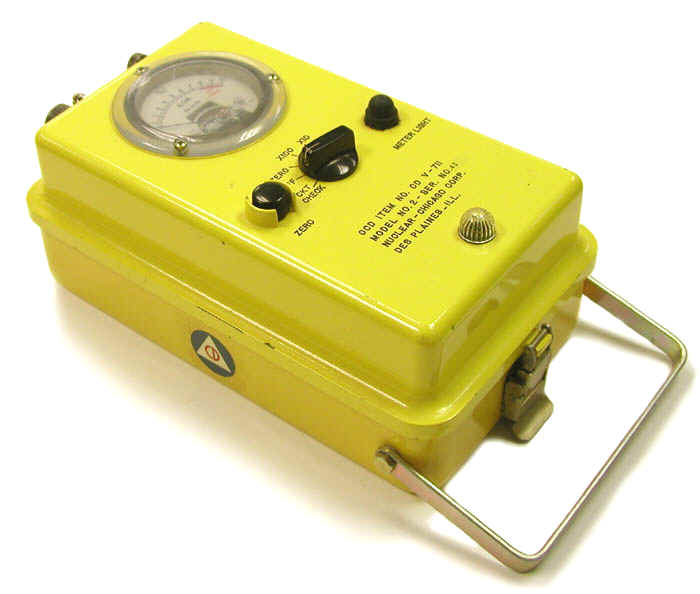
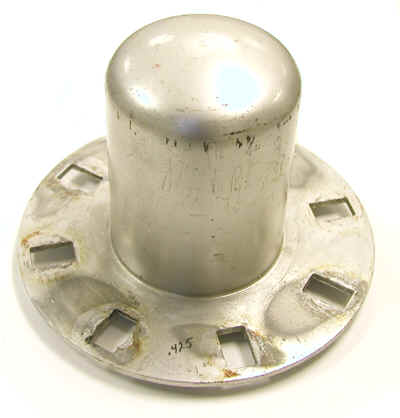
The CD V-711 was a remote sensing meter designed to measure the exposure rates from nuclear blasts. It was intended as a semi-permanent installation in the local emergency operations centers (EOC) where the carrying handle could be used to hang the meter from a wall-mounted bracket. Note that the bottom of the case in the above photo is backwards because the meter would be hanging upside down ;-)
The CD V-711 had three controls: a range switch, a zero adjust, and a button to turn on the meter light. The ion chamber, positioned at some remote location outside the shelter, was typically connected to the meter via a 300' cable. I was told that it could operate with up to 2000 feet of cable, if necessary.
The example pictured in the top photo is a CD V-711 Model 2 (Serial No. 43) manufactured by Nuclear-Chicago. The remote ion chamber (photo above right) employs a blast resistant cap capable of withstanding a 100-psi overpressure.
Detector: Remote pressurized ion chamber
Range: 0-1, 0-10, 0-100, 0-1,000 R/h
Size: 6.25” x 10.25” x 4”
Batteries: Nine 1.5 volt batteries for the Model 2. The Model 1 employed a 12 volt car battery charged via 110 volt line current.
Battery lifetime: 36 hours for Model 1
Materials: Aluminum
Manufacturer: Nuclear Chicago
The 1959 revision of Civil Defense Bulletin TB-11-20 Radiological Instruments for Civil Defense contained a description and photograph of the CD V-711 Model 1, but noted that it was under development and not available for distribution. Nevertheless, the 1962 Annual Statistical Report from the Office of Civil Defense (OCD) indicated that 200 "Fixed Station Monitoring" meters had been procured through Fiscal Year 1958. This early Model 1 version of the 711 was powered by a 12-volt car battery and very different looking than the Model 2 pictured here.
My assumption is that the Office of Civil and Defense Mobilization (OCDM) was quite unhappy with the unit and ordered the development of a radically different version. The OCDM's 1961 Annual Report stated "Oak Ridge National Laboratory is designing a general purpose monitoring instrument for control center use in remote measurement of gamma dose rates in the 1 to 1,000 roentgens per hour range." Later, an article in the January 1962 issue of Nucleonics indicated that this instrument was still under development at Oak Ridge National Laboratory and that the R&D designation was CD-711BX. The 1962 Office of Civil Defense Annual Report indicated that Oak Ridge National Laboratory began work on this instrument, the "Remote Reading Fixed Station Radiation Monitor V-711BX," in February of 1961. According to the 1963 OCD Annual Statistical Report, the Model 2 finally went into production in 1963 when 200 units were procured.
Sometime later, Nuclear Chicago produced a "Mark III" version of the CD V-711. Volume 6 of CPG 4-1 (Sept. 25, 1985) indicated that "two hundred CD V-711 Mark III Remote Sensor Radiation Meters were produced under an engineer development contract" and that "FEMA has granted all of these instruments to the states." This brought the total number of CD V-711s that had been procured to 600 (200 Model 1s, 200 Model 2s and 200 Mark IIIs)
The following photo shows the Mark III meter (Serial Number 18), but unfortunately the accompanying detector is missing. Kindly donated by the Health Physics Society.
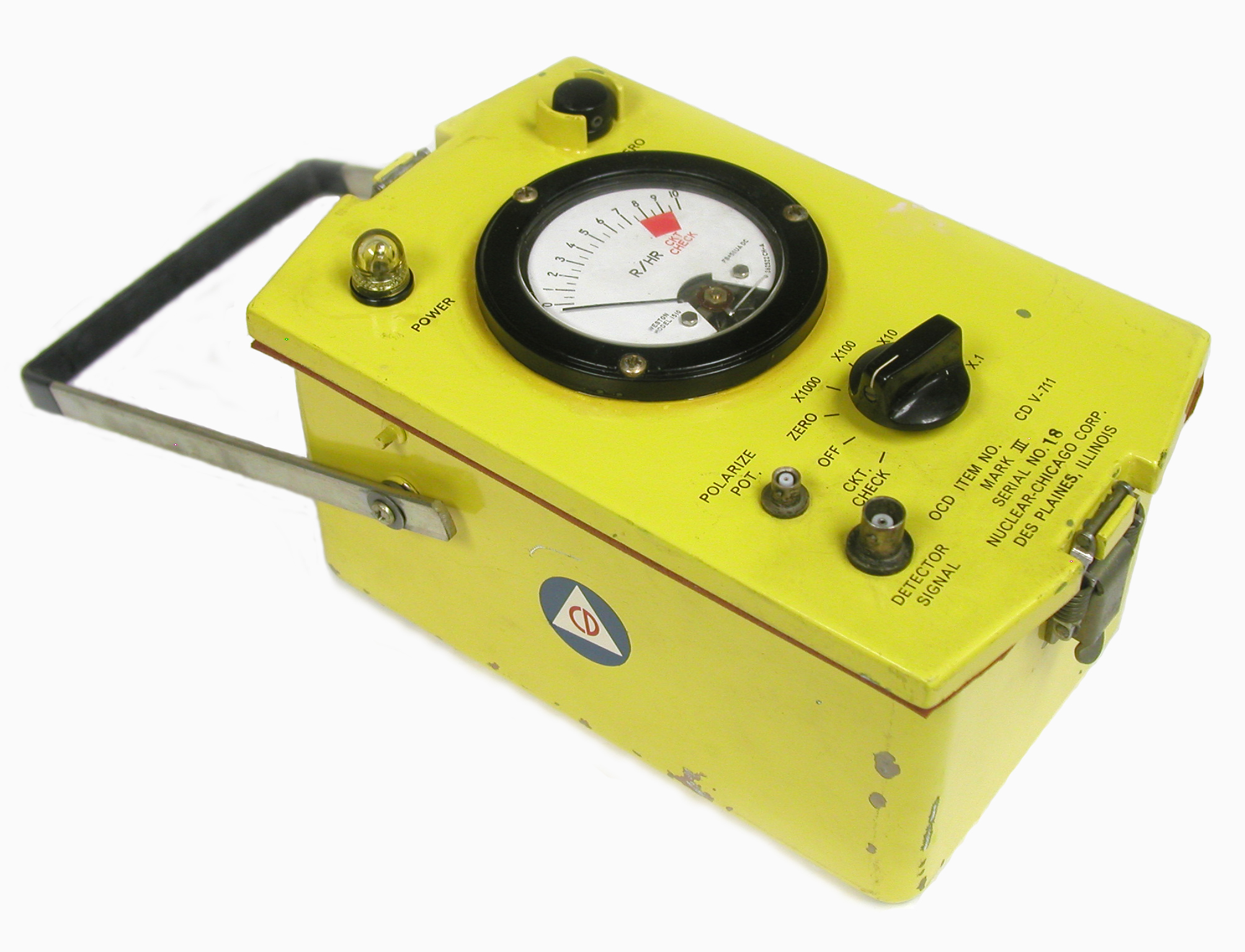
The DCPA's Annual Statistical Report for FY 1972 (July 1971-June 1972) indicated that 400 CD V-711s had been procured by FY 1972 and that 200 of these had been disposed of, while the FY 1974 report indicated that 600 had been procured with 200 being disposed of. As such it would seem that the CD V-711 Mark III was distributed sometime between 1972 and 1974.
Range: 0-1, 0-10, 0-100, 0-1,000, and 0-10,000 R/hr
Size: ca. 5 1/2" x 9" x 4 1/2"
Batteries: Three 1.5 volt "D" cells
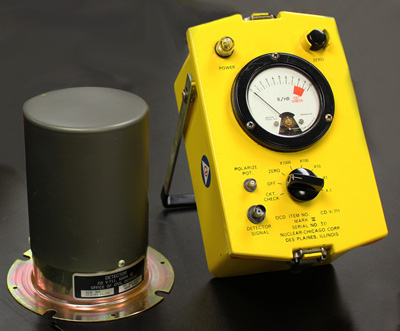
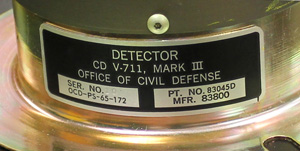
The image to the left shows another example of the Mark III meter (Serial Number 10) in the collection. Fortunately, we have the detector for this one. The chamber is approximately 4" in diameter and 6" high. A close-up of the label on the bottom of the chamber is shown below.
It would also seem that Nuclear Chicago's development of the Mark III was a slow process. One of the two examples that I have seen of a Mark III had a label on the inside dated 1967. The example in the ORAU collection has a calibration sticker dated 1968. The identification plate on one detector chamber reads: "Detector CD V-711. Mark III. Office of Civil Defense. OCD-PD-65-173." Since the "65" probably refers to 1965, it is likely that the initial development of the Mark III began that year. Four years later, the OCD FY 1969 Annual Report included a description and photo (see below) of the Mark III. In this report, the instrument in the photo is referred to as "a pilot production model." By the time the Mark III was finally distributed, the OCD had become the DCPA and, unless I am mistaken, Nuclear Chicago had ceased to exist.
The following figure, from the OCD Annual Report for 1969, shows the CD V-711 Mark III.
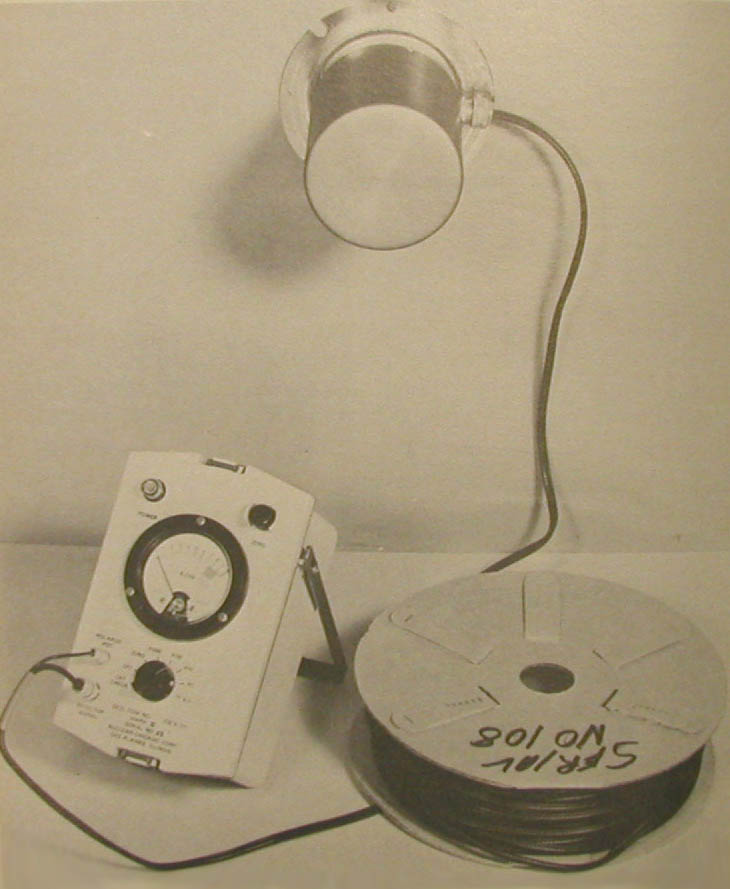
No instruction and maintenance manuals were produced for the Mark III.
Unfortunately, the ORAU collection has neither the meter or chamber for the Model 1 nor the chamber for the Mark III.
CD V-711 Model 2 donated by the Federal Emergency Management Agency courtesy of Carl Siebentritt. The Mark III was donated by the Health Physics Society.
References
- FEMA, Radiological Instruments: An Essential Resource for National Preparedness, CPG 3-1/September 1986.
- How Civil Defense Measures Harmful Radiation, Nucleonics, January 1962 p. 67-68.
- Operating and Maintenance Instructions, Jordan Model 711 Model No. 1, no date.
- Marlow Stangler and Carl Siebentritt, personal communication.
